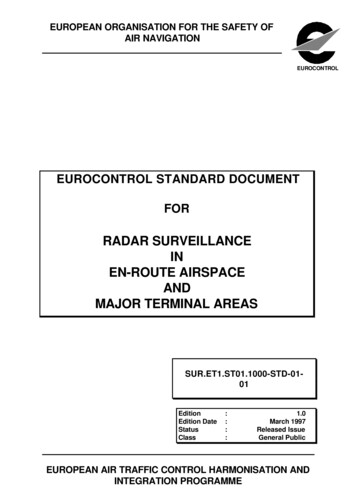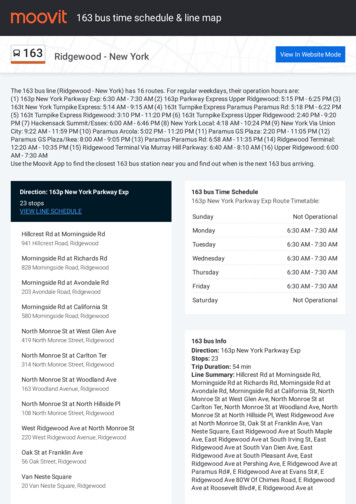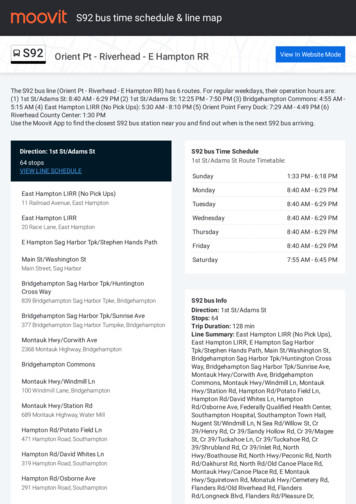
Transcription
For decades, Pitt hasbeen an “intellectualengine” for prehospitalcare, starting with CPRand the first highlytrained paramedics.12PITTMED9456 12to18c3.indd 122/11/15 2:08 PM
FOG RR EA P H I CFI NEATUP IT T PEOPLE PAVED THE W AYTEXT BY JENNY BLAIR WITH ERICA LLOYDILLUSTRATIONS BY STACY INNERSTTHE RUSHTO THE HOSPITALPaul Paris (MD ’76), a University of Pittsburgh professor of emergencymedicine and the ERMI Professor of Healthcare Quality, has spent muchof his career studying prehospital emergency care. But he remembers thepre-EMS (emergency medical service) era all too well. In 1972, when he was a medical student at Pitt, a police paddy wagon was called to transport his gravely ill mother to the hospital. At the time, no citywide EMS existed in Pittsburgh. Americanambulances then often carried little more than first aid supplies anyway.Things soon changed. Prehospital care began to take shape. Ambulances began todeliver care as well as deliver patients. Cities founded ambulance services. Many ofthese advances were sparked here, under the guidance and scrutiny of Pitt researchers.Just the idea that rescuers should follow a protocol, for example, was preached earlyby Pitt luminary, the late Peter Safar, MD Distinguished Professor of ResuscitationMedicine. In addition to co-inventing and then advocating for CPR, Safar developed the resuscitation ABCs (airway, breathing, circulation) in the late 1950s. Themnemonic has, in various forms, been the foundation of emergency care ever since.National standards were born here, too. After a 1966 white paper decried the dismal survival rates for auto and other accidents in this country—trauma victims hada better chance on the battlefield—the nation began to standardize prehospital care.It was Safar and critical care fellow-turned-faculty member the late Nancy Caroline,an MD, who developed a curriculum for paramedics here in the 1970s. She alsoauthored the nation’s first textbook for paramedics, which was published in 1979.Her Emergency Care in the Streets is now in its seventh edition.After many an ambulance ride-along, Caroline knew what she was talking about.Between 1967 and 1975, Pittsburgh hosted one of the country’s first professionalWINTER 20159456 12to18c3.indd 13132/11/15 2:08 PM
ambulance services offering advanced care.Cofounded by Safar with the Falk Foundation’sPhil Hallen, Freedom House Ambulance Servicewas staffed by African American emergencymedicine technicians; they were among thenation’s first to be trained to a high standard.Caroline served for a year as its director andfrequently joined the paramedics, who servedAfrican American neighborhoods (that had beenbarely served previously) and other parts of thecity, as well. When the City of Pittsburgh set upits own EMS program in the 1970s, Pitt’s futurefounding chief of the Division of EmergencyMedicine, Ronald Stewart, an MD, signed on asthe city’s medical director. (Stewart, who is fromNova Scotia, experienced baptism by fire in EMSwith LA County’s progressive program, of whichhe was the founding medical director.) ManyEMS program leaders throughout the nation cuttheir teeth here, notes Paris.The U.S. Department of Transportationadopted Caroline’s curriculum for FreedomHouse in 1977, and recently called it “the foundation for all prehospital advanced life supporteducation today.” National curricula, guidelines,and textbooks for first responders continue tocome from the efforts of Pitt people, notablythe University’s Walt Stoy, a paramedic and PhDprofessor and director of emergency medicine inthe School of Health and Rehabilitation Sciences.Prehospital Emergency Care, edited since its1997 founding by Pitt’s James Menegazzi, aPhD, was the first peer-reviewed EMS journal.By 2010, EMS had gained enough scientificA ROUTE BROUGHT TO YOUBAA AMBUL ANCE S THAT W ORKEDbacking to become an official subspecialty of theAmerican Board of Medical Specialties. Much ofthat backing came from Pitt faculty. Pitt has beenan “intellectual engine” for many EMS advancements, notes Donald Yealy, an MD and chairof the School of Medicine’s Department ofEmergency Medicine. In some cases, Pitt peopleinvented an idea that caught on; in others, theystudied and spearheaded ideas born elsewhere.But every American EMS crew today does whatit does in large part because of Pitt.14When Pittsburgh antipoverty activists teamed up with Pitt’sPeter Safar to create the Freedom House Ambulance Service,they didn’t skimp on training. Its African American paramedics may have been the country’s most skilled, using ECGs andairway equipment at a time when many ambulances carriedonly first aid supplies or less. Word of their competencegot around. (Eventually, police officers would call FreedomHouse for their own family members in need, instead ofcalling the police.) The U.S. Department of Transportationhas noted that Freedom House technicians were “pioneersin the field of EMS.” (The service’s director Nancy Carolinewould later be nicknamed the “Mother Teresa of Israel,”after leaving Pitt in the ’70s to build a prehospital program inthat country.) A recently placed historical marker on CentreAvenue honors the Freedom House team.To read more of Freedom House’s extraordinary story,see tinyurl.com/freedomh2004B OXYGEN NATIONThe gentle press of a pulse oximeter on a patient’s earlobe or fingertip tells paramedics whether a patient’shemoglobin is saturated with oxygen or whether it’stime to, say, secure a path to the lungs or give oxygen.Pitt researchers studied and adopted the measurementof this “fifth vital sign” in prehospital care ahead ofmany other centers, pointing out in a 1989 study ofits use in air medical transport that the oximeter wasoften the only sign the patient was desaturating tolife-threateningly low levels of oxygen. Around thesame time, pulse ox monitors were becoming commonplace in hospitals. More prehospital studies followed,and the devices are now ubiquitous in medevac helicopters and ambulances.C EARLY AIRWAY ACCE SSSometimes the best way to make air enter the lungsis to place a breathing tube. Teaching paramedics howPITTMED9456 12to18c3.indd 142/11/15 2:08 PM
BY PIT T DOC SEFDCD LIGHTING THE WAYwas a far-out idea when Pitt researchers began doing soin the ’70s, a time when anesthesiologists weren’t surethey liked the idea of even emergency medicine physicians encroaching on what was traditionally their territory. But Ronald Stewart’s 1984 study in Chest showeda more than 94 percent success rate in cardiac arrest orcomatose patients in the field. These days, most cardiopulmonary arrest patients in the United States receivea prehospital breathing tube. Yet Pitt has continued torevisit the wisdom of the practice. In the 2000s, HenryWang, an MD, then an emergency medicine facultymember at Pitt, pointed out that some medics go yearsbetween intubations. Studying field intubations, hefound they can interrupt CPR, replace less risky optionslike noninvasive positive airway pressure masks, andfail all too often. Wang’s colleagues, including Pitt’sClifton Callaway, an MD (Res ’96), and Jestin Carlson,an MD (Res ’10, Fel ’12), have been monitoring fieldintubations with video to help determine what worksand what doesn’t. “This and other research,” says PaulParis, “has helped define the best tools and indicationsfor airway management.”Intubation is tricky: You’re apt to push the tube down theesophagus instead of the trachea. Ronald Stewart, PaulParis, and others did the first study of the use of a lightedstylet—that is, a light pushed into the tube itself—forprehospital intubations. They used a surgical light thatStewart shrink-wrapped to keep the bulb from falling intothe patient’s lungs. In the late ’80s, an updated versionof the stylet, then found in many paramedic toolkits,captured interest and spurred other airway innovations.E ABCs & CPRAfter publishing a 1958 landmark paper on mouth-tomouth ventilation, Peter Safar combined that expertisewith Johns Hopkins colleagues’ findings on chest compressions to develop the ABCs (airway, breathing, andcirculation) of resuscitation, the now-iconic system forCPR training. With Norwegian anesthesiologist BjornLind and toymaker Asmund Laerdal, Safar helped createthe CPR mannequin Resusci Anne in 1960. (For more ofthe story behind Anne, see p. 40.) As founding chair ofPitt’s Department of Anesthesiology in the 1960s and’70s, Safar advocated so strongly for CPR that he earnedthe nickname the “father of CPR.” In 1979, he foundedwhat is now called the Safar Center for ResuscitationResearch at Pitt.To read more about Peter Safar’s monumental contributions: tinyurl.com/Safar-Oct99F CPR QUALIT YThe right compression depth, full chest recoil, properspeed, and no interruptions: It’s not enough just togive CPR; you’ve got to do it right. Sloppy CPR candoom a patient. Following two studies that warned ofpoor-quality CPR in American hospitals and NorwegianEMS units, Pitt researchers like Clifton Callaway andJames Menegazzi began to study the issue. CPR is muchless effective, they found, if defibrillation is involved,if rescuers pause after shocking the heart, or if they’redoing it on a moving stretcher instead of the floor. Thanksto insights like these, as well as improved hospital care,survival rates to discharge for prehospital cardiac arrestcare have more than doubled in Pittsburgh since the late’90s, from about 6 percent to 15 percent. The nationwide Resuscitation Outcomes Consortium reports similartrends in the past 10 years. That translates to tens ofthousands of lives saved a year, notes Paul Paris.WINTER 20159456 12to18c3.indd 15152/11/15 2:08 PM
GHKIJG SKIPPED A BEATParoxysmal supraventricular tachycardia (PSVT) is aspeedy heart rhythm that can sometimes keep the heartfrom having enough time to fill. To treat dangerous bouts,providers can use a drug called adenosine, which “pauses”the heart briefly. The provider pushes it in fast, eyeing themonitor. The heart flatlines, and the patient experienceswhat is commonly described as a kick in the chest or a feeling of doom. When the drug wears off a few seconds later, anormal beat often resumes. Brows are wiped. Pitt was thefirst center to study adenosine for PSVT in the prehospitalsetting. Now it’s part of standard Advanced Cardiac LifeSupport protocol and the Pitt-authored paramedic NationalStandard Curriculum.H STICKER SHOCKA pacemaker can save a life in cardiac arrest brought on bya slow heart rate, but it doesn’t have to be the implantedkind. Shocks to the surface of the chest can pace the heart,too, if the electrodes are stuck on soon after the deadlyrhythm begins. In a series of studies in the late ’80s, Pitt’sPaul Paris and Ronald Stewart did early investigationsof transcutaneous pacing (which uses external pads) inthe field. The researchers also subjected brave residentvolunteers to the procedure, including Vincent MosessoJr. (MD ’88, Res ’91), who is now a professor of emergencymedicine and medical director for prehospital care atUPMC. The City of Pittsburgh’s EMS system adopted transcutaneous pacing in 1993.16I FUZZ BUZZIn an era when automatic defibrillators are in every mall, it’sworth remembering that there was a time when only healthcare workers were trusted with them. But police oftenarrive before paramedics at the scene of an emergency.So in the early ’90s, Vincent Mosesso Jr. organized a pilotprogram for police—one of the first two groups to do sonationwide. The studies found that when police did arrivebefore EMS and shock patients, the patients were 10 timesmore likely to survive to hospital discharge than thoseshocked when EMS arrived. Today, about three-quarters ofthe country’s state police agencies train officers to operatedefibrillators.J DEFIB FOR L AYPEOPLEOn his birthday in 2001, a Washington, D.C., lawyer namedRichard Brown was jumping rope at the gym when he collapsed in cardiac arrest. Trainers leapt to perform CPR, thendefibrillated him and restored a normal rhythm. The veryautomated external defibrillator (AED) that saved Brown’slife was one he himself had urged the gym to get justweeks earlier after a friend had collapsed and died there.Brown is now executive director of the Sudden CardiacArrest Association, a patient-led advocacy group originatingfrom Pitt. The organization, formerly known as the NationalCenter for Early Defibrillation, was launched in 2000 byPitt’s Paul Paris and Vincent Mosesso Jr. as a way to expandaccess to AEDs after a pilot program showed that city policecould use them effectively (see “Fuzz Buzz”). Sponsors proffered the profs a large grant to establish a national center ofexcellence, and the association has since offered advice andresources for starting AED programs. As of 2012, roughly amillion AEDs were in place around the country, with half abillion dollars spent annually placing more. (Though we arejust figuring out where they all are; see p. 6.)K ALL THUMB SRescuers of infants in cardiorespiratory arrest have longbeen taught to push on the chest with two fingers. Pitt’sJames Menegazzi was the first to examine the option ofan alternative two-thumb infant CPR method in a series ofpiglet studies beginning in 1993. The two-thumb method,he found, is easier and delivers a higher blood pressure tothe arrest victim. Since 2000, it’s been the American HeartAssociation’s method of choice for reviving infants whenthere are two professional rescuers present.L COMFORT ZONEWhile pain management in ambulances still isn’t adequate—recent studies found astonishingly high rates ofuntreated pain from broken limbs—EMS crews do havegood options. For decades, Pitt people have been evaluat-PITTMED9456 12to18c3.indd 162/11/15 2:09 PM
MNLOing ways to not only save lives, but also make people comfortable and find calm in emergencies. A 1983 Pittsburghstudy found that a 50/50 oxygen/nitrous oxide (laughinggas) mix was a safe and effective option for pain relief inambulances. Yet no company was interested in funding astudy on generic nitrous oxide to gain FDA approval. Sincethen, Pitt faculty members have advocated for paramedicsto administer other analgesics, notably fentanyl. Perhapsmost importantly, as textbook authors and national leaderson prehospital pain management, Pitt docs encourage EMSpersonnel to take people’s need for relief seriously.M SK Y C ALLIf you’re struck by sudden chest pain at 35,000 feet, there’sa good chance Pitt docs will get involved. UPMC’s STATMD Commercial Airline Consultation Services is one ofonly two such centers in the nation, handling hundreds ofcalls from commercial flights every month. In a 2013 NewEngland Journal of Medicine article, Pitt emergency medicine physicians Donald Yealy (Res ’88, Fel ’89), who chairsPitt’s department, and Christian Martin-Gill (Res ’08, Fel’10) reported that most commercial-flight emergenciesinvolve syncope (fainting), breathing problems, or vomiting, and that a doctor was available to help in about half ofall cases. Of 11,920 calls throughout nearly three years,there were 30 in-flight deaths and three early landingsfor childbirth.O HIT THESTREETS RUNNINGN SO FLYTwenty years ago, Pitt’s Peter Winter, an MD who was thenchair of anesthesiology, created a simulation facility for Pittmed students and hospital providers to practice procedureson responsive mannequins rather than real patients. Sincethen, the Peter M. Winter Institute for Simulation, Education,and Research (WISER) has grown tremendously. WISER continues Pitt’s long relationship with Resusci Anne manufacturer,Laerdal, testing and developing new mannequins and software. And the Laerdal family has generously supported WISERthrough its foundations. Among the very first sophisticatedsimulation centers in a medical school, WISER has becomeintegral to Pitt med. Many other health sciences students trainthere too, and so do Pittsburgh paramedics. The Center forEmergency Medicine even shares the building; and WISER’sdirector, Paul Phrampus, an MD (Res ’00), has an extensivebackground assessing and testing EMS providers. As medschools throughout the country have followed suit by buildingtheir own simulation centers, their local EMS crews are typicallyable to practice airway management and other crisis scenarioson simulators, where it’s okay to make mistakes. This should translate to better trained emergency responders.Headed by Pitt associate professor of emergency medicine Francis X. Guyette (Res ’04, Fel ’06), the Pitt-affiliatedSTAT MedEvac program is the nation’s largest nonprofit critical care transport group, with 17 helicopters;its 36,700 square mile service area includes Baltimore.The program is also a world leader in aeromedicineresearch. For example, its crew was among the first totest the feasibility of video laryngoscopy for insertingbreathing tubes during air transport. And STAT MedEvaccan test trauma patients for a spike in lactic acid, whichcan happen when you’re bleeding internally and meansyou’re more likely to require emergency surgery or bloodproducts. (They can give you the blood right there onboard and are studying the best way to do this, too.)Their research findings on point-of-care lactate havesince been replicated by the Resuscitation OutcomesConsortium. “It’s really dramatic what they are doing inthe small, hectic environment of a flying helicopter now,”notes Paul Paris.WINTER 20159456 12to18c3.indd 17172/11/15 2:09 PM
AND WHERE IT ’S GOINGA PEEK AT HOW PREHOSPITAL C ARE MAY BE CHANGINGUPMC emergency medicine residents are probably the only ones in the country who rotate with paramedics. In the ’70s, house staff went on calls in PaulParis’s purple Buick Skylark. UPMC now provides a dedicated Jeep.CUFF ’EMFor heart attacks, limiting the size of the damage to cardiac muscle is a key goal of care. Remote ischemic conditioning is a simple way to trick the body into a smallerheart attack by inflating and deflating a blood pressurecuff. Invented in Europe, the procedure was recentlytested for the first time in medevac helicopters byChristian Martin-Gill and colleagues, who found it usefuland effective enough to study further at Pitt’s AppliedPhysiology Lab. It might not be long before paramedicsput the squeeze on prehospital heart-attack care.BAREFOOT MEDICSCommunity paramedicine is a new field that trainsparamedics to enter patients’ homes and help themmanage chronic diseases—a strategy Paul Paris calls“the next EMS frontier.” Pitt’s Congress of NeighboringCommunities launched CONNECT CommunityParamedics in 2009, partnering with the Center forEmergency Medicine and other key organizations inPittsburgh.DON’T STRE SSAt Pitt’s Applied Physiology Lab, a team of researchers, including emergency medicine physicians JonRittenberger and Joe Suyama, studies health questionsrelated to stresses emergency rescuers face, like wear-18ing hot, heavy equipment (a timely topic in the Ebolaera). They’re examining how fatigue and teamwork affectEMS providers’ ability to give care, too.Outcomes Consortium, which includes Pitt, is pursuinga study comparing both techniques head-to-head (or chest-to-chest, as it were).FEEDBACK LOOPDid we mention that CPR quality matters?It really, really does. Yet the rescuer oftendoesn’t know moment by moment whetherher efforts are actually helping. With a recent 1.8 million grant from the National Heart,Lung, and Blood Institute, James Menegazziand colleagues are building a powerfuldatabase of electrocardiograms (ECGs) thatresearchers can digitally analyze in order totrack how ECG changes during CPR correlateto patient survival. The aim is to give betterreal-time feedback during CPR and, of course,save more lives.BACK TO BA SICSCompressions with or without interruptionsfor breaths? In 2008 the American HeartAssociation advised untrained bystandersattempting CPR to stick with compressionsalone, because it’s simpler. “But it hasn’t beentested [to see] whether it’s better for patients,”notes Clifton Callaway. The ResuscitationROUGH RIDERSOddly enough, emergency physicians seldom spend muchtime in ambulances.
The gentle press of a pulse oximeter on a patient’s ear-lobe or fi ngertip tells paramedics whether a patient’s hemoglobin is saturated with oxygen or whether it’s time to, say, secure a path to the lungs or give oxygen. Pitt researchers studied and adopted the measuremen











